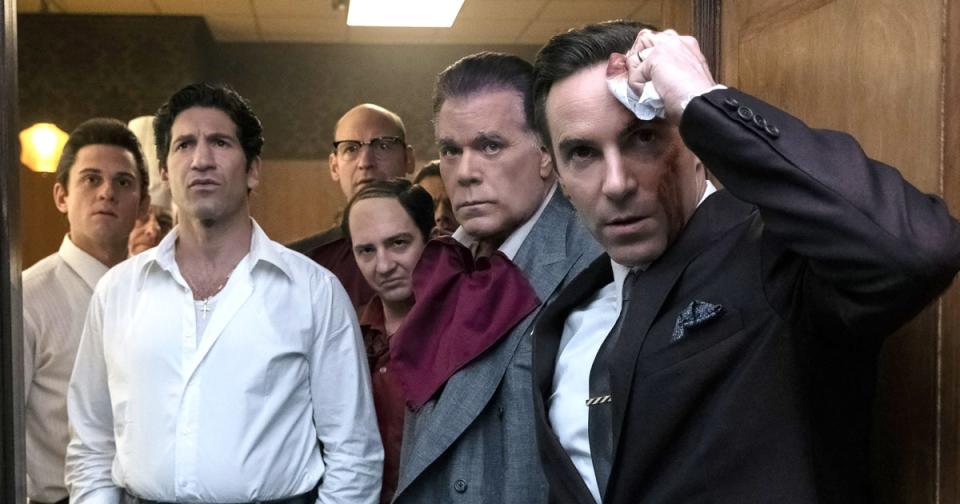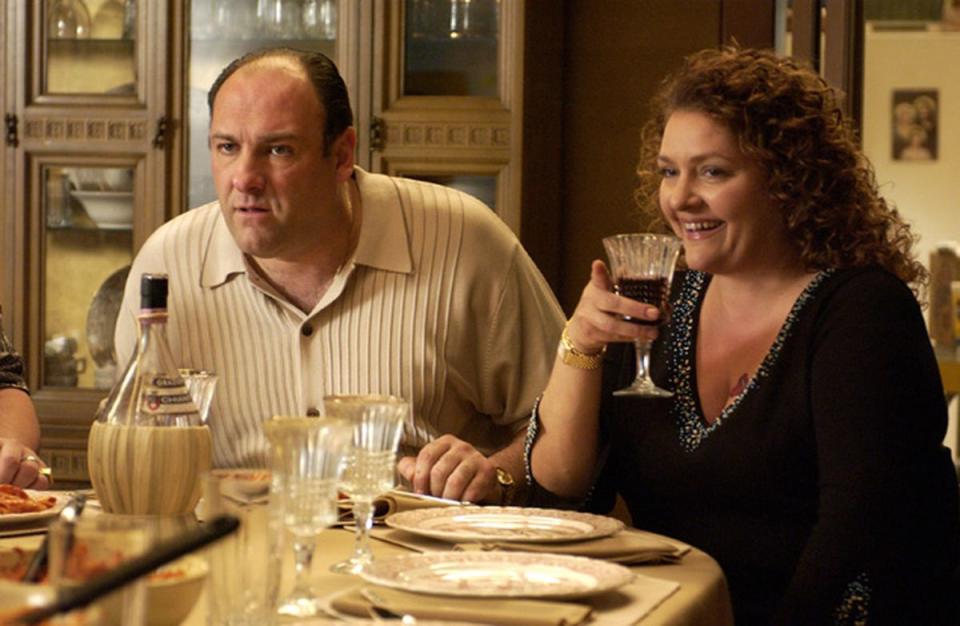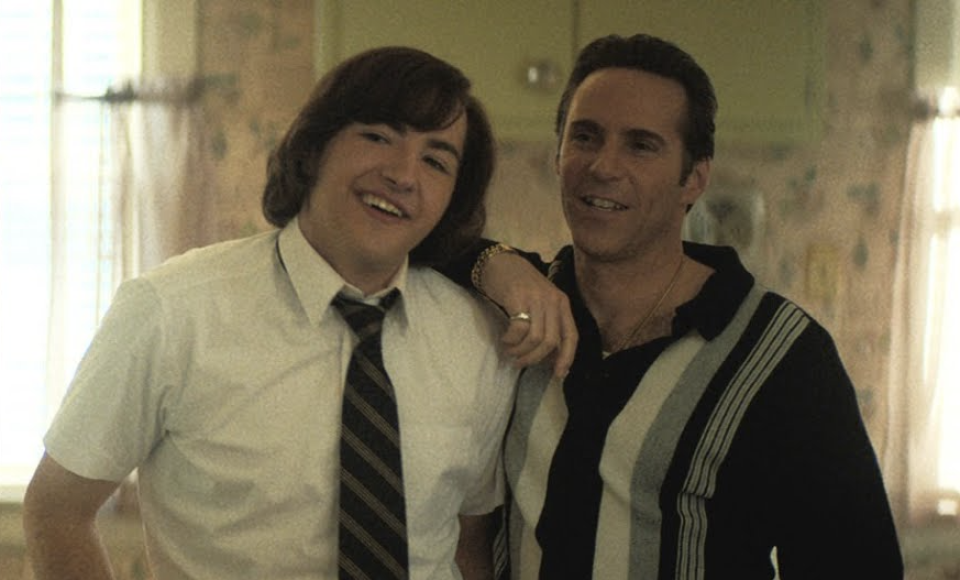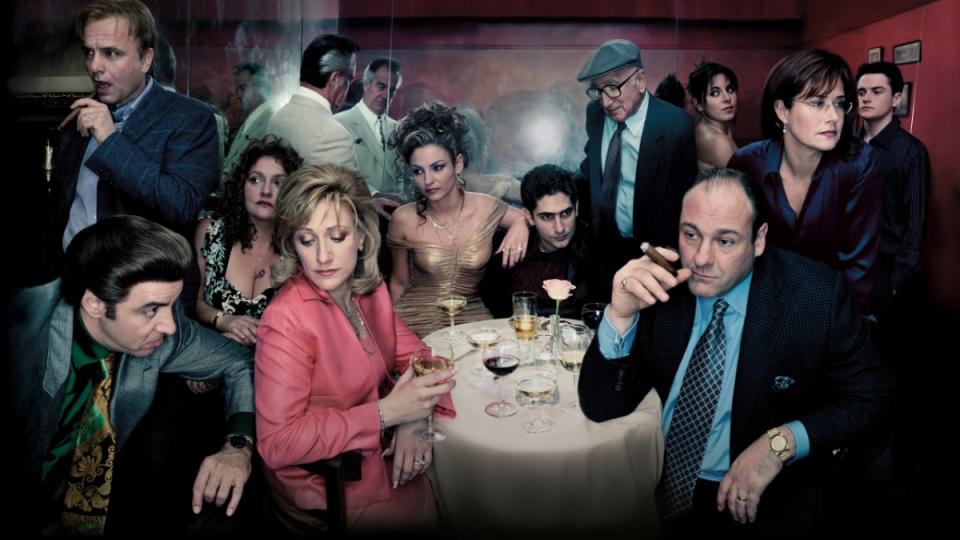Fahgettaboudit: How ‘The Sopranos’ and ‘The Many Saints of Newark’ Forget About the Mob’s Daughters

- Oops!Something went wrong.Please try again later.
- Oops!Something went wrong.Please try again later.
In the opening scenes of Alan Taylor’s “The Many Saints of Newark,” Christopher Moltisanti’s ghost rises from the concrete of Pier 49 to follow his father, Dickie Moltisanti (Alessandro Nivola), and eight-year-old Tony Soprano (William Ludwig). Young Tony skips through the sharply dressed ‘60s-era crowd, play-fighting with his Uncle Dickie. The piercing cry of three seagulls sweeps across the pier. Young Tony smiles. And the disembodied voice of Christopher describes how, 40 years from now, this grinning kid, his very own Uncle Tony, will murder him.
Nearly all of the stories in “The Sopranos” universe are told by men and boys: The newest is even narrated by a male ghost. Women of “The Sopranos” tend to be preternaturally voiceless, silenced, beaten, or all three, at least when they are not seducing men or complaining. Young girls and daughters experience this misogyny twofold, and “The Many Saints of Newark” carries on “The Sopranos” tradition of rendering young girls all but invisible, forgetting about daughters.
More from IndieWire
Like “The Sopranos” before it, “The Many Saints of Newark” follows the fraught premise of a mafia family in which children are often protected from a culture of violence waged principally among adults. Like most gangster movies, the film is gritty, but is still cloaked in an air of glamour. Christopher Moltisanti may be the film’s omniscient narrator, but we see this world through the admiring eyes of young Tony.
Persistently popular, mobster movies are a genre that often espouse a complicated dichotomy: that the American dream is possible with both the right connections and a healthy dose of corruption. But the way the children of the DiMeo crime family are depicted in both “The Sopranos” and “The Many Saints of Newark” offers a dangerous romanticization of a reality far more terrifying than either the film or beloved HBO series that inspired it.
Being born to a violent organized crime boss father is not romantic or glamorous: It is a childhood that nearly killed me. While the film and HBO series show that children are not completely sheltered from the nebulous boundary between family and “Family,” it still does not accurately portray how harrowing the reality actually was for myself and many others who survived similar childhoods.

Warner Bros.
Both “The Many Saints of Newark” and “The Sopranos” introduce their audience to “likable” antihero gangster parents who are inherently flawed, but trying the best they know how. This persistent pop culture trope glamorizes organized crime and is a far cry from the brutally violent reality I endured as a child. This is not to advocate for graphic child abuse on screen, but rather that through exposition, a more accurate, less romantic depiction of childhood — especially for the mob’s daughters — in a criminal family could and should be portrayed instead.
While other recent films and series about organized crime, including the Aussie feature film “Animal Kingdom” and the Italian series “Gomorrah” convey the darkness of this world without the romanticization, many American projects, including “The Sopranos” and “The Many Saints of Newark,” often fail to capture the same nuance.
In the film, Janice’s confirmation opens with her father, Giovanni “Johnny” Soprano (Jon Bernthal), making a toast to his daughter on the occasion of becoming a woman. Her mother Livia (Vera Farmigia) scoffs and stubs out a cigarette. Janice sits silent through her father’s speech, as she is throughout most of the movie. This quiet 14-year-old Janice is a far cry from the outspoken elder sister (played by Aida Turturro) who annoyed her mafioso brother in Season 2 of “The Sopranos” and stuck up for her teenage niece Meadow’s autonomy in ways that no one ever did for her.
A woman congratulates young Janice on her confirmation and tells her that the saint she chose in church, St. Apollonia, is the patron saint of dentists. A martyr whose teeth were shattered when she was tortured, St. Apollonia foreshadows Janice’s own domestic violence fate when she will be punched in the jaw 30 years later by future fiancé (and fellow mobster) Richie Aprile, before she finally snaps.
It’s a refrain I recall my mother telling me when I was a child: “Your dad shows love in his own way.” Often, that was through violence. I didn’t know how to tell my teacher and the principal what had happened, and I was too ashamed to undress and show them my bloody bruises. Rarely do domestic abusers only harm their romantic partners; children are also frequent casualties. To depict mobsters’ children as somehow divinely spared and insulated from their parents’ violence is inaccurate and fetishizes the realities of being born into a dangerous family of which you might not make it out.
There are a handful of instances in “The Sopranos” in which adult Tony is physically abusive toward his son, slapping Anthony Jr. (Robert Iler) and brashly pulling him out of bed. This is tame compared to the unspeakable violence I, and others like me, barely survived. To portray organized crime’s violence as artificially contained among adult characters glosses over the lifelong injuries that many other children of gangsters sustained in our childhoods.

Like Johnny Soprano and his son Tony Soprano (later played in the film by Michael Gandolfini), my dad brought his work home with him, too. As a child, I would wake to find my dad hiding money throughout the house, or defrosting the freezer because he had hidden stacks of cash beneath the ice. The one time he agreed to drive me to a soccer match, he spent half the game pacing on the other team’s side of the field, distractedly negotiating what I think was a drug deal. The soccer moms turned away from their own children to stare at me, searching for an explanation, then back at my dad. I was humiliated. The first time I saw a gun up close, it was when my parents were trying to kill each other. I ran to the kitchen to shovel ice cream into bowls for my younger siblings’ breakfast so they would stay preoccupied and not risk getting caught in my parents’ crossfire.
Then there are the times my dad stole my identity, like the time he named five-year-old me CEO of his company, something I would spend years paying back taxes for, because tax agents and supervisors said it didn’t matter how old I was. By the time I realized what had happened, I was a naïve homeless teenager who didn’t know to call a lawyer for anything other than jail or divorce. I negotiated a monthly payment with the IRS, and remained homeless while working two food-service jobs to pay off my dad’s tax debt accrued in my name and SSN. Those are the more benign examples, and while I can’t say with certainty that all crime-boss dads are like my own, there’s a certain irony to the fact that the word “mobster” is just one letter away from “monster.”
Like my own father, Johnny Soprano also used his kids, particularly Janice, for cover. Taylor’s film revisits a pivotal scene in which Johnny Soprano is arrested at a local amusement park. In the film, young Janice (Mattea Conforti) screams and her little brother Tony looks like he’s about to cry as they watch police push their handcuffed father into a police van. In the background are happier shrieks from other children, with presumably non-criminal parents. The sequence is a callback to episode 7, Season 1 of “The Sopranos” when adult Tony (James Gandolfini) flashed back to this key memory in a session with Dr. Melfi (Lorraine Bracco) while discussing fatherhood in a capital-F Family. Adult Tony tells his therapist, “This amusement park is where I found out that my father wasn’t like other fathers.”
In both renditions of the scene, Johnny Soprano uses his daughter as a cover story for clandestine meetings at the carnival, pulling her into the family business without her knowledge. She is blissfully ignorant, at least until her dad is arrested. When I watched my own father get arrested, it was at home, and it simultaneously made me fear police and also feel relieved that my dad might leave us alone however briefly, granting us a reprieve from his rage.

Warner Bros.
The ways in which my own father roped my siblings and me into his worklife were far more insidious than what’s portrayed in either “The Sopranos” or its prequel. Several times, my father’s “work” nearly resulted in my death or my brother’s death as children. My dad trafficked humans, drugs, and me. He tortured and locked me in isolation with no food or water for days, justifying his sadistic punishments by citing infractions like I had played outside and gotten my socks dirty, “talked back,” or didn’t do well on a math test. He repeatedly kidnapped me from my bed while I was sleeping, and I’d wake up scared and disoriented in the passenger’s seat as we drove down the freeway in another state, the landscape unrecognizable.
There is little doubt the daughters of “The Sopranos” are interesting enough to deserve more screen time, both on the series and even in this prequel feature. One of the greatest tragedies of the series and film is that Janice didn’t manage to stay away from her family, even after she ran away after high school, only to return 20 years later when their mother Livia was hospitalized.
There are persistent fan theories that Janice joined the Rajneeshees cult before returning home to New Jersey in the second season of “The Sopranos.” There are countless details and unanswered questions about the 20 years in between Janice’s confirmation and when she returns to New Jersey, ostensibly to help care for her ailing mother. Wearing a very ‘90s hippie ensemble that looks like it smells of patchouli, Janice recites Zuni parenting idioms to Carmela and Tony, mentions that her son Hal is homeless somewhere, and provides a very confusing story about the disability pension that she received after sustaining a work injury involving an espresso steam wand while working at a coffee shop in Seattle – or was it Olympia?
Her failed attempts to run away from her family and start a new life embodies the feminine trajectory of perhaps the most famous cinematic mob child of all: Michael Corleone (Al Pacino) in “The Godfather.” Janice Soprano’s narrative connection to Michael Corleone is also found in her chosen St. Apollonia, as Michael fell in love with Apollonia Vitelli at first sight and married her in Sicily. If “The Many Saints of Newark” is testing audience interest in more stories about “The Sopranos,” Janice would make for a fascinating protagonist. She’s not the most likable character, but Janice has 20 years’ worth of adventures as she attempted over and over again to lead a normal life away from her family. If only she could figure out what “normal” means.
Barbara Soprano might appear to be the most square Soprano sibling of all, but the mechanics of how she learned to maintain boundaries with her family is intriguing. Just a baby in “The Many Saints of Newark,” the most we see of the youngest Soprano is when Livia blows cigarette smoke at infant Barbara in her stroller. But at least she’s not a ghost. Based on her limited portrayal in “The Sopranos,” Barbara seems to have made it out successfully, not as an apparition that haunts her family like Christopher. I want to know how she did it.
Perhaps my experience would have been different if I had been born a boy. Perhaps I would resonate more with Tony Soprano’s own childhood experiences. But my father saw me as a resource, not a daughter. I was subhuman; property to be owned. This became obvious to me at age eight, a day my father brought me to “work” with him, the same age as Tony Soprano in the opening scenes of “The Many Saints of Newark.”
My dad lifted me high upon his shoulders, feet dangling down his arms. My fingers laced tightly through his curly Sicilian-Irish hair. He pointed at a vintage white convertible with a red leather interior. “This was Marilyn Monroe’s. You’ll get this when you turn 16 if you’re a good girl,” he told me. I only vaguely knew who Marilyn Monroe was, and it looked like there was blood splattered on the back of the driver’s seat. He gave me a tour: smashed and stacked cars towered precariously on either side, punctuated with stolen BMWs and Porsches that gleamed in the harsh sunlight, waiting for my dad’s employees to file down the VIN numbers to resell with fraudulent titles.
This was only one of my dad’s expansive criminal enterprises, and arguably the least violent. He was arrested often, but always released because my dad had a side hustle as a confidential police informant. Most people tend to think of confidential informants as a clever plot twist in a Scorsese mobster movie. In my life, it has meant that no matter what my dad has done to me, my younger siblings, or his other victims, he seems to have total impunity.
“Someday, this will all be yours,” my dad gestured like a game show host. I followed his arm, confused about why I, an eight-year-old-girl, would want a chop shop. Sure, I liked making sculptures and some of the scrap metal would have been fun to make art with, but I didn’t want to inherit a dusty razorwire lot of broken vehicles. He clarified: All I needed to do in exchange for this prize was marry the son of one of his “associates.”

HBO
With my dad, there were always strings attached, even to things I didn’t want. Even at the tender age of eight, having witnessed my own parents’ marriage, the last thing I wanted to do was marry anyone, especially not someone my father chose for me. It was clear that he saw me as his property, just like all the stolen cars in his network of chop shops scattered across the city. Maybe if I had been a boy, my relationship with my dad would have been different. Maybe if I had been a boy, my dad would not have tried to arrange a marriage for me with another organized crime family.
Moments before the Moltisantis gather together on the pier with eight-year-old Tony, three seagulls sweep through. Gracefully punctuating the shot of the massive passenger ship from Italy, the birds echo the family of ducks that will drive Tony to his first therapy session with Dr. Melfi decades later. Like albatross harbingers warning that all three Moltisantis in the scene will eventually be murdered, “The Many Saints of Newark” carries on “The Sopranos” legacy of birds as poetic omens.
There is no fourth bird for Christopher, because he is a ghost, not yet born in the story he’s telling. Then again, there are lots of birds in Newark. They can’t all be omens, can they?
A Warner Bros. release, “The Many Saints of Newark” is now in theaters and streaming on HBO Max.
Sabra Boyd is a freelance writer and “retired” child actor working on a memoir about surviving child sex trafficking, teen homelessness, and being born on the set of the Coen brothers movie “Raising Arizona.” She lives in Seattle where she writes about exploitation, healthcare, food and agriculture, homelessness, human trafficking, tech, and cults. Her work will be included in the anthology The Women of Jenji Kohan, coming out in March 2022.
Best of IndieWire
New Movies: Release Calendar for October 8, Plus Where to Watch the Latest Films
45 Directors Pick Favorite Horror Movies: Bong Joon Ho, Tarantino, del Toro and More
'Copshop' Breaks Through in Action-Crazy Specialty Box Office Rankings
Sign up for Indiewire's Newsletter. For the latest news, follow us on Facebook, Twitter, and Instagram.

